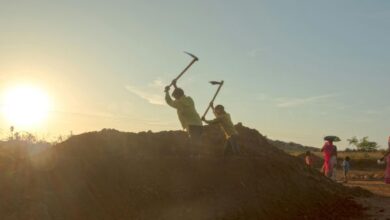When the Bard met the Mahatma

 After reaching Shantiniketan on March 5, 1915, and meeting Rabindranath Tagore, Mahatma Gandhi, with the former’s concurrence, introduced cleaning of the kitchen and its surroundings by the students and teachers of Shantiniketan on March 6.
After reaching Shantiniketan on March 5, 1915, and meeting Rabindranath Tagore, Mahatma Gandhi, with the former’s concurrence, introduced cleaning of the kitchen and its surroundings by the students and teachers of Shantiniketan on March 6.
Mahatma Gandhi stayed for a week and completely won over the community that they were prepared to dispense with cooks and servants and do all the work themselves.
It was Gandhi’s work in South Africa that made him known to Tagore, and in his matter Tagore’s friend C.F. Andrews and one of his colleagues at Santiniketan, W.W. Pearson, played an important role.
Both Mahatma Gandhi and Tagore held each other in high mutual regard. Tagore was one of the first important people to call Gandhi ‘Mahatma’, that is the ‘Great Soul’. Gandhi, in turn, called Tagore ‘Gurudev’, meaning ‘divine teacher’. It was in April of 1919 that Tagore, for the first time, addressed Gandhiji as ‘Mahatma’.
Mahatma said, “I regard the Poet as a sentinel warning us against the approach of enemies called Bigotry, Lethargy, Intolerance, Ignorance, Inertia and other members of that brood.”
At a glance, one could notice the differences between the two of them. While Tagore was tall, with long hair and beard and wearing a beautiful choga (gown), Gandhi was much smaller and wore only a simple dhoti and kurta. Despite the fact that Gandhi and Tagore had opposing personalities, they struck up a friendship that lasted until Tagore’s death in 1941.
Sabyasachi Bhattacharjee in his book The Mahatma and The Poet: Letters and Debates between Gandhi and Tagore 1915-1941 had rightly pointed that Tagore’s tranquil courage in facing the revulsion of popular feelings against him was matched by Gandhi’s generosity in allowing the right of criticism. It was their correspondence in the form of letters that was collected and assembled in a book that covered everything from the country’s independence to boycotting imported textiles. These letters serve as candid and personal images of two contemporaries who were both friends and intellectual rivals.
Gandhi criticised Tagore’s educational approach for not being simple and self-sufficient enough and even suggested changing the structure of Tagore’s school considerably, for example, by making students do all the cleaning themselves. Tagore, on the other hand, did not approve of all aspects of Gandhi’s non-cooperation movement and the importance he gave to the charkha.
Especially on non-cooperation movement, Tagore reflects, “Our fight is a spiritual fight, it is for Man. We are to emancipate Man from the meshes that he himself has woven round him, these organisations of National Egoism. The butterfly will have to be persuaded that the freedom of the sky is of higher value than the shelter of the cocoon. If we can defy the strong, the armed, the wealthy, revealing to the world power of the immortal spirit, the whole castle of the Giant Flesh will vanish in the void. And then Man will find his swaraj. We, the famished, ragged ragamuffins of the East, are to win freedom for all Humanity. We have no word for Nation in our language. When we borrow this word from other people, it never fits us. For we are to make our league with Narayan, and our victory will not give us anything but victory itself; victory for God’s world. I have seen the West; I covet not the unholy feast, in which she revels every moment, growing more and more bloated and red and dangerously delirious. Not for us, is this mad orgy of midnight, with lighted torches, but awakenment in the serene light of morning.” (Source: Tagore’s reflections on non-cooperation and cooperation; The Calcutta journal Modern Review of May 1921 carried Setters inspired by Gandhi’s Non-cooperation movement; addressed to C.F. Andrews, London, 1928)
Tagore was also averse to encouraging superstition, so when Gandhi linked the Bihar earthquake with supreme punishment for ostracising people as “untouchables”, Tagore spoke out against Mahatma Gandhi’s response.
One of Mahatma Gandhi’s earliest letters to Tagore (January 21, 1918) was regarding the fourth Congress session in Calcutta, in which Gandhi asked Tagore if the conference could be held in Hindi or Urdu. Tagore stated that it was not feasible, adding that English was the only language that people from several states, including Madras, could communicate in.
Everybody was well aware about Gandhi’s opinion on the Charkha or the spinning wheel. Besides taking it as a symbol of liberating the Indians from bondage and slavery and making them self-reliant, Gandhi’s spiritual discourses (read ideas) on the charkha was well-known. He praised the charkha, referring to it as Annapurna (the giver of food and nourishment), Kamdhenu (a wish-fulfilling cow), Yajna (a ritual sacrifice), an instrument for those seeking Brahmacharya (celibacy), and the gateway to Moksha (spiritual salvation). This drew a lot of criticism from a variety of sources.
Tagore, on the other hand, wrote a scathing piece titled ‘The Cult of the Charkha’ in Modern Review, a prestigious Calcutta-based magazine, Gandhi’s stature and nationalist passions were at an all-time high — focus on “more important things”. Tagore once mentioned about Gandhiji’s call for plying charkha for half an hour every day and asked why not eight and half hours, if it could help the country, in gaining freedom or Swaraj.
This exchange of ideas has been called “the noble debate” by French writer and Nobel laureate Romain Rolland, which “embraces the whole globe and the whole humanity joins in this august dispute”.
However, to the outside world, Tagore never hesitated to project Gandhi as the spiritual soul of India. He wrote to China’s Marshal Chian Kai Sek in 1938 saying, “At this desperate age of moral upset it is only natural for us to hope that the continent which has produced two greatest men, Buddha and Christ, in the whole course of human events must still fulfil its responsibility to maintain the purest expression of character in the teeth of the scientific effrontery of the evil genius of man. Has not that expectation already shown in its first luminous streak of fulfilment in the person of Gandhi in a historical horizon obscured by centuries of …?” Chiang Kai Sek replied to the letter (concern on Japan China conflict) as “Respected Gurudev Tagore”.
On May 20, 1932, Gandhi went on a fast in Yerwada Jail protesting against separate electoral representation for backward Hindus. Tagore sent a telegram to Gandhiji saying, “It is well worth sacrificing precious life for the sake of India’s unity and her social integrity. Though we cannot anticipate what effect it may have upon rulers who may not understand its immense importance for our people, we feel certain that the supreme appeal of such self-offering to the conscience of our own countrymen will not be in vain. I fervently hope that we will not callously allow such national tragedy to reach its extreme length. Our sorrowing hearts will follow your sublime penance with reverence and love.”
The same day Gandhiji wrote a letter to Tagore saying, “This is early morning 3 o’clock of Tuesday. I enter the fiery gate at noon — if you can bless the effort. I want it. You have been to me a true friend because you have been a candid friend often speaking your though aloud. I had looked forward to a firm opinion from you one or the other. But you have refused to criticize. Though it can now only be during my fast. I will yet prize your criticism, if your heart condemns my action. I am not too proud to make an open confession of my blunder, whatever the cost of confession, I find myself in error. If your heart approves the action I want your blessing. It will sustain me I hope I have made myself clear. My love.”
A note was added by Gandhi to this letter, “Just as I was handing this to the Superintendent, I got your loving and magnificent wire. It will sustain me in the midst of the storm I am about to enter”. (Source: Rabindra Rachanawali, Vol. 14)
Worried about the health of Mahatma Gandhi, fasting in Yerwada Jail, Tagore reached Pune to see for himself. Gandhi sent his son to escort Tagore inside. By that time, the British Government had accepted the demand of Mahatma Gandhi and Gandhi agreed to break his fast. Kamala Nehru prepared the juice and Kasturba Gandhi offered the sip. Tagore was requested by Gandhi to sing a self-composed song. He sang jiban jakhan shukai e jai, karunadharai eso (When the heart is hard and parched up, come upon me with a shower of mercy).
Mahatma Gandhi visited Tagore’s school and university in Santiniketan on four occasions — twice with Kasturba Gandhi and twice alone. In 1936, Tagore reached Delhi with his Dance Drama team after visiting Allahabad and Lucknow with the purpose of collecting funds for Vishwa Bharati to tide over the money crunch. This left Gandhi sad to see that his Tagore at such an old age moving around collecting funds. Gandhiji met him and arranged the money.
In 1940, a year before Tagore’s death, Gandhi along with his wife Kasturba Gandhi went to see the ailing poet, where Tagore asked him to take charge of Vishwa Bharati after his absence. In his last visit to Shantiniketan, in 1945, Gandhi visited an institution still lamenting the loss of its Tagore. Gandhi addressed the community saying, “It is my conviction … that Gurudev as a person was much bigger than his works; bigger even than this institution.”
As a writer puts it, “Mahatma Gandhi and Gurudev Rabindranath Tagore were, politically and ideologically speaking, extremely different. But that did not stop them from forming a strong bond of fellowship, based on mutual respect for one another’s efforts and differences. Their individual impacts on India are incomparable, their legacies are immortal, their friendship was eternal.”





